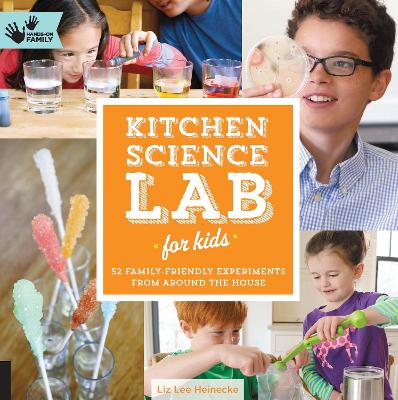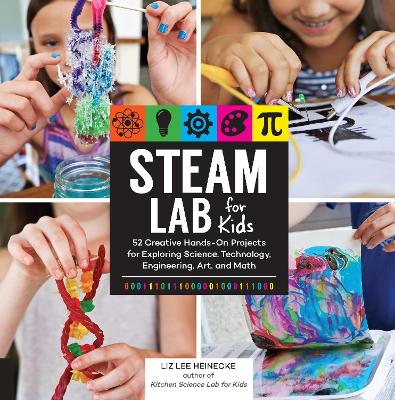Lab for Kids
3 primary works
Book 4
In Kitchen Science Lab for Kids, mom and scientist Liz Lee Heinecke presents 52 family-friendly labs that introduce fundamental scientific principles in a fun and accessible format.
Following clear, photo-illustrated step-by-step instructions, have fun exploring:
- Microbiology by growing your own microbe zoo on a homemade petri plate.
- Rocket science by making and launching bottle rockets, using water and a bike pump.
- Physics—marshmallow slingshots serve as a lesson on the transformation of energy and an egg-throwing experiment demonstrates the law of motion.
- And so much more! Other great projects explore the exciting science of crystals, static electricity, acidification, and solar energy.
Along with the experiments, you’ll find:
- Tips for keeping a science journal.
- Suggestions for taking your experimentation to the next level with “Creative Enrichment.”
- Accessible explanations of “The Science Behind the Fun.”
- Safety tips and hints.
The experiments can be used as part of a homeschool curriculum, for family fun, at parties, or as educational activities for groups. Many of the experiments are safe enough for children as young as toddlers and exciting enough for older kids, so families can discover the joy of science together.
The popular Lab for Kids series features a growing list of books that share hands-on activities and projects on a wide host of topics, including art, astronomy, clay, geology, math, and even how to create your own circus—all authored by established experts in their fields.
Each lab contains a complete materials list, clear step-by-step photographs of the process, as well as finished samples. The labs can be used as singular projects or as part of a yearlong curriculum of experiential learning. The activities are open-ended, designed to be explored over and over, often with different results. Geared toward being taught or guided by adults, they are enriching for a range of ages and skill levels.
Gain firsthand knowledge on your favorite topic with Lab for Kids.
Book 6
Inspire a lifelong passion for science and nature with these outdoor physics, chemistry, and biology experiments for kids!
In Outdoor Science Lab for Kids, scientist and mom Liz Heinecke presents 52 family-friendly labs designed to get kids outside in every season. From playground physics to backyard bugs, this book makes it fun and easy to dig into the natural sciences and learn more about the world around you.
Following clear, photo-illustrated step-by-step instructions, have fun learning about:
- The laws of physics by constructing and using a marshmallow catapult.
- Centripetal forces by swinging a sock filled with gelatin snack and marbles.
- Earthworms by using ground mustard seed dissolved in water to make them wriggle to the surface.
- Germination by sprouting a sapling from a pine cone or tree seed.
- Surface tension and capillary action by growing baking soda stalagmites and stalactites.
- And so much more!
Along with the experiments, you’ll find:
- Tips for keeping a science journal.
- Suggestions for taking your experimentation to the next level with “Creative Enrichment.”
- Accessible explanations of “The Science Behind the Fun.”
- Safety tips and hints.
The experiments can be used as part of a homeschool curriculum, for family fun, at parties, or as educational activities for groups. Many of the simple and inexpensive experiments are safe enough for toddlers, yet exciting enough for older kids, so families can discover the joy of science and STEM education together.
*Outdoor Science Lab for Kids was a 2017 Finalist for the AAAS/Subaru Prize for excellence in science books.*
The popular Lab for Kids series features a growing list of books that share hands-on activities and projects on a wide host of topics, including art, astronomy, clay, geology, math, and even how to create your own circus—all authored by established experts in their fields.
Each lab contains a complete materials list, clear step-by-step photographs of the process, as well as finished samples. The labs can be used as singular projects or as part of a yearlong curriculum of experiential learning. The activities are open-ended, designed to be explored over and over, often with different results. Geared toward being taught or guided by adults, they are enriching for a range of ages and skill levels.
Gain firsthand knowledge on your favorite topic with Lab for Kids.
Book 17
While many aspiring artists don’t necessarily identify with STEM subjects, and many young inventors don’t see the need for art, one is essential to the other. Revealing this connection and encouraging kids to explore it fills hungry minds with tools essential to problem solving and creative thinking.
Each of the projects in this book is designed to demonstrate that the deeper you look into art, the more engineering and math you’ll find.
Following clear, photo-illustrated step-by-step instructions, learn about:
- Angular momentum by creating tie-dyed fidget spinners.
- Electrical conductors by making a light-up graphite-circuit comic book.
- Kinetic energy by constructing a rubber-band racer car.
- Parabolic curves by creating string art with pushpins and a board.
- Symmetry by making fruit and veggie stamp paintings.
- And much more!
Along with the creative, hands-on activities, you’ll find:
- Suggestions for taking your projects to the next level with “Creative Enrichment.”
- Accessible explanations of the “The STEAM Behind the Fun,” including cross-disciplinary related topics.
- Safety tips and hints.
The projects can be used as part of a homeschool curriculum, for family fun, at parties, or as educational activities for groups. Many of the activities are safe enough for children as young as toddlers and exciting enough for older kids, so families can discover the joy of STEAM together.
The popular Lab for Kids series features a growing list of books that share hands-on activities and projects on a wide host of topics, including art, astronomy, clay, geology, math, and even how to create your own circus—all authored by established experts in their fields.
Each lab contains a complete materials list, clear step-by-step photographs of the process, as well as finished samples. The labs can be used as singular projects or as part of a yearlong curriculum of experiential learning. The activities are open-ended, designed to be explored over and over, often with different results. Geared toward being taught or guided by adults, they are enriching for a range of ages and skill levels.
Gain firsthand knowledge on your favorite topic with Lab for Kids.


